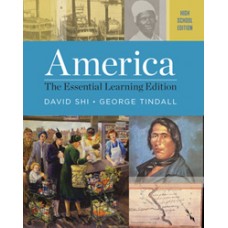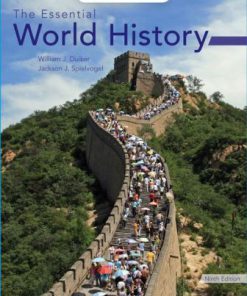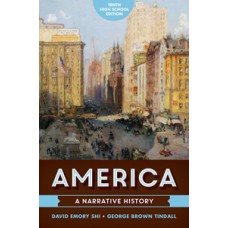Test Bank for America The Essential Learning Edition, High School Edition
$35.00 Original price was: $35.00.$26.50Current price is: $26.50.
Test Bank for America The Essential Learning Edition, High School Edition
This is completed downloadable of Test Bank for America The Essential Learning Edition, High School Edition

Product Details:
- ISBN-10 : 0393265072
- ISBN-13 : 978-0393265071
- Author: David E. Shi (Author), George Brown Tindall (Author)
An essential narrative of American history, with a focus on core learning objectives in the text and online, now available with a high school binding.
Lively yet concise, The Essential Learning Edition of America blends Shi and Tindall’s unrivalled narrative style with innovative pedagogy to help students understand major historical developments and strengthen critical interpretive skills. Online adaptive learning tools enhance and assess students’ mastery of the core objectives from the text.
Table of Content:
- Part 1: An Old “New” World
- Chapter 1: The Collision of Cultures in the Sixteenth Century
- Early Cultures in the Americas
- The Expansion of Europe
- The Spanish Empire
- The Columbian Exchange
- The Spanish in North America
- Reviewing the Core Objectives
- Chapter 2: England and Its American Colonies, 1607–1732
- The English Background
- Settling the American Colonies
- Native Peoples and English Settlers
- Servitude and Slavery in the Colonies
- Thriving Colonies
- Reviewing the Core Objectives
- Chapter 3: Colonial Ways of Life, 1607–1750
- The Shape of Early America
- Women in the Colonies
- Society and Economy in the Colonies
- Race-Based Slavery in the Colonies
- First Stirrings of a Common Colonial Culture
- Reviewing the Core Objectives
- Chapter 4: From Colonies to States, 1607–1776
- French and British Colonies
- Warfare in the Colonies
- Tightening of Control over the British Colonies
- Road to the American Revolution
- Reviewing the Core Objectives
- Thinking Like a Historian: Debating the Origins of the American Revolution
- Part 2: Building a Nation
- Chapter 5: The American Revolution, 1775–1783
- American Society at War
- Mobilizing for War
- Setbacks for the British (1777–1781)
- War as an Engine of Change
- Equality and Its Limits
- Reviewing the Core Objectives
- Chapter 6: Securing the Constitution and Union, 1783–1800
- The Confederation Government
- Creating the Constitution
- The Fight for Ratification
- The Federalist Era
- Foreign and Domestic Crises
- Reviewing the Core Objectives
- Chapter 7: The Early Republic, 1800–1815
- Jeffersonian Republicanism
- War in the Mediterranean and Europe
- The War of 1812
- The Aftermath of the War
- Reviewing the Core Objectives
- Thinking Like a Historian: Debating Thomas Jefferson and Slavery
- Part 3: An Expanding Nation, 1815–1860
- Chapter 8: The Emergence of a Market Economy, 1815–1850
- The Market Revolution
- Industrial Development
- Immigration
- Organized Labor and New Professions
- Reviewing the Core Objectives
- Chapter 9: Nationalism and Sectionalism, 1815–1828
- A New Nationalism
- Debates over the American System
- “An Era of Good Feelings”
- Nationalist Diplomacy
- The Rise of Andrew Jackson
- Reviewing the Core Objectives
- Chapter 10: The Jacksonian Era, 1828–1840
- Jacksonian Democracy
- Nullification
- Jackson’s Indian Policy
- Political Battles
- Jackson’s Legacy
- Reviewing the Core Objectives
- Chapter 11: The South and Slavery, 1800–1860
- The Distinctiveness of the Old South
- The Cotton Kingdom
- Whites in the Old South
- White over Black: Unequal Society in the South
- Forging an Enslaved Community
- Reviewing the Core Objectives
- Chapter 12: Religion, Romanticism, and Reform, 1800–1860
- A More Democratic Religion
- Romanticism in America
- The Reform Impulse
- The Anti-Slavery Movement
- Reviewing the Core Objectives
- Thinking Like a Historian: Debating Separate Spheres
- Part 4: A House Divided and Rebuilt
- Chapter 13: Western Expansion and Southern Secession, 1830–1861
- Moving West
- The Mexican-American War
- Slavery in the Territories
- The Emergence of the Republican Party
- The Southern Response
- Reviewing the Core Objectives
- Chapter 14: The War of the Union, 1861–1865
- Mobilizing Forces in the North and South
- Emancipation
- The War behind the Lines
- The Faltering Confederacy
- A Transformational War
- Reviewing the Core Objectives
- Chapter 15: The Era of Reconstruction, 1865–1877
- The War’s Aftermath in the South
- Battles over Political Reconstruction
- Black Society under Reconstruction
- The Grant Administration
- Reconstruction’s Significance
- Reviewing the Core Objectives
- Thinking Like a Historian: Debating Reconstruction
- Part 5: Growing Pains
- Chapter 16: Business and Labor in the Industrial Era, 1860–1900
- The Elements of Industrial and Agricultural Growth
- The Rise of Big Business
- The Alliance of Business and Politics
- A Changed Social Order
- Organized Labor
- Reviewing the Core Objectives
- Chapter 17: The New South and the New West, 1865–1900
- The Myth of the New South
- The Failings of the New South
- Race Relations during the 1890s
- The Settling of the New West
- Life in the New West
- The Fate of Western Indians
- The End of the Frontier
- Reviewing the Core Objectives
- Chapter 18: Political Stalemate and Rural Revolt, 1865–1900
- America’s Move to Town
- The New Immigration
- Changes in Culture and Thought
- Gilded Age Politics
- Corruption and Reform: Hayes to Harrison
- Unhappy Farmers and the “Money Problem”
- Reviewing the Core Objectives
- Chapter 19: Seizing an American Empire, 1865–1913
- Toward the New Imperialism
- Expansion in the Pacific
- The Spanish-American War
- Consequences of Victory
- Roosevelt’s “Big-Stick” Diplomacy
- Reviewing the Core Objectives
- Thinking Like a Historian: Debating the Annexation of the Philippines
- Part 6: Modern America
- Chapter 20: The Progressive Era, 1890–1920
- The Progressive Impulse
- The Varied Sources of Progressivism
- Progressives’ Aims and Achievements
- Progressivism under Roosevelt and Taft
- Woodrow Wilson: A Progressive Southerner
- Reviewing the Core Objectives
- Chapter 21: America and the Great War, 1914–1920
- An Uneasy Neutrality
- Mobilizing for War
- The American Role in the War
- The Politics of Peace
- Stumbling from War to Peace
- Reviewing the Core Objectives
- Chapter 22: A Clash of Cultures, 1920–1929
- A “New Era” of Consumption
- The “Jazz Age”
- The Modernist Revolt
- The Reactionary Twenties
- Republican Resurgence
- Reviewing the Core Objectives
- Chapter 23: The Great Depression and the New Deal, 1933–1939
- The Causes of the Great Depression
- The Human Toll of the Depression
- From Hooverism to the New Deal
- Roosevelt’s New Deal
- The New Deal under Fire
- The Second New Deal
- Reviewing the Core Objectives
- Chapter 24: The Second World War, 1933–1945
- The Rise of Fascism in Europe
- From Isolationism to Intervention
- Mobilization at Home
- The Allied Drive toward Berlin
- The Pacific War
- A New Age Is Born
- Reviewing the Core Objectives
- Thinking Like a Historian: Debating the United States’ Response to the Holocaust
- Part 7: The American Age
- Chapter 25: The Cold War and the Fair Deal, 1945–1952
- Truman and the Cold War
- The Containment Policy
- Expanding the New Deal
- The Cold War Heats Up
- Another Red Scare
- Reviewing the Core Objectives
- Chapter 26: Affluence and Anxiety in the Atomic Age, 1950–1959
- Moderate Republicanism: The Eisenhower Years
- A People of Plenty
- Cracks in the Picture Window
- The Early Years of the Civil Rights Movement
- Foreign Policy in the Fifties
- Reviewing the Core Objectives
- Chapter 27: New Frontiers and a Great Society, 1960–1968
- The New Frontier
- Expansion of the Civil Rights Movement
- Lyndon Baines Johnson and the Great Society
- The Tragedy of Vietnam
- The Turmoil of the Sixties
- Reviewing the Core Objectives
- Chapter 28: Rebellion and Reaction, 1960s and 1970s
- “Forever Young”: The Youth Revolt
- Social Activism Spreads
- Nixon and the Revival of Conservatism
- “Peace with Honor”: Ending the Vietnam War
- The Nixon Doctrine and a Thawing Cold War
- Watergate
- Reviewing the Core Objectives
- Chapter 29: Conservative Revival, 1977–2000
- The Carter Presidency
- The Rise of Ronald Reagan
- The Reagan Revolution
- An Anti-Communist Foreign Policy
- The Changing Economic and Social Landscape
- The Presidency of George H. W. Bush
- The Clinton Presidency (1993–2001)
- Reviewing the Core Objectives
- Chapter 30: Twenty-First-Century America, 2000–Present
- America’s Changing Population
- A Chaotic Start to a New Century
- Second-Term Blues
- The Obama Administration
- The Trump Administration
- Sideswiped by a Pandemic
- Biden’s First 100 Days
- Reviewing the Core Objectives
- Thinking Like a Historian: Debating Contemporary Immigration and the Uses of History
- Glossary
- Appendix
- The Declaration of Independence (1776)
- Articles of Confederation (1787)
- The Constitution of the United States (1787)
- Amendments to the Constitution
- Presidential Elections
- Admission of States
- Population of the United States
- Immigration by Region and Selected Country of Last Residence, Fiscal Years 1820–2020
- Legal Immigration to the United States
- Presidents, Vice Presidents, and Secretaries of State
- Further Readings
- Text Credits
- Photo Credits
- Index
- Endpapers
People Also Search:
america the essential learning edition high school edition
america the essential learning edition high school edition download scribd
america the essential learning edition high school edition test bank download pdf
america the essential learning edition high school edition pdf
You may also like…
Test Bank
Test Bank for Essential Environment The Science Behind the Stories, 4th Edition : Withgott
Test Bank
Test Bank for The Principles of Learning and Behavior Active Learning Edition 7th Edition by Domjan
Test Bank
Test Bank for Transforming the School Counseling Profession, 5th Edition, Bradley T. Erford
Test Bank
Test Bank for The Principles of Learning and Behavior Active Learning Edition, 6th Edition: Domjan












